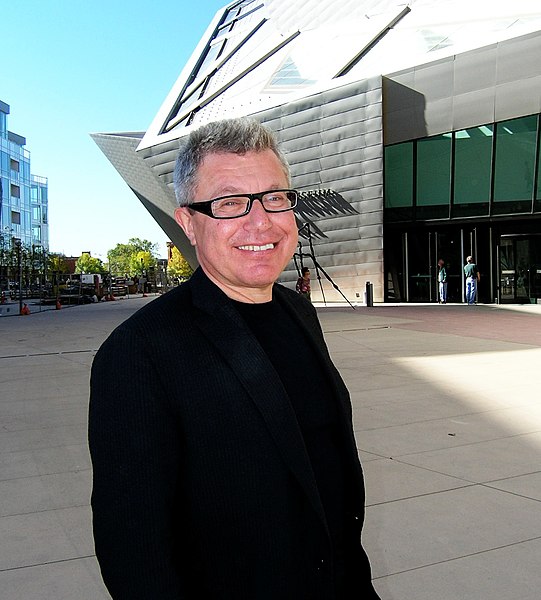 |
| Daniel Libeskind (https://upload.wikimedia.org/wikipedia/commons/thumb/1/11/Daniel_Libeskind.jpg/541px-Daniel_Libeskind) |
From designing the Dancing Towers in Seoul, South Korea, to the New York Tower for residential use, to the 9/11 Memorial in New York, Daniel Libeskind has left his mark all over the world through his eye-catching architecture. His designs combine today's modern architecture with his Polish background. Libeskind always considers how he can add his own twist into a typical structure to make it unique. His architecture is the perfect combination between organic and sophisticated. Daniel Libeskind inspires everyone, especially me, through his everlasting designs.
Daniel Libeskind was an incredible child from the start. In Lodz, Poland, his hometown, he was an intellectual genius. But he also exhibited a strong passion for music. At the age of six, he appeared on Polish television, playing the accordion. But as a teenager, he immigrated to the United States and abandoned his musical passion. Instead, he pursued another incredible way to express his creativity: architecture. Libeskind studied architecture and then taught architecture for a number of years. He spent his time developing his theory of design rather than actually designing buildings. On an architecture camp in 1966, Daniel Libeskind met Nina Lewis, his future wife. A few years later, Libeskind and Lewis married. Instead of going on a traditional honeymoon, they traveled all across the United States looking at famous pieces of architecture. I find that this was very inspirational because after he finished his learning of architecture, instead of going on a solo career, he wanted to help students to get them to where he was. I also found it interesting because you can't really teach architecture. Sure, you can teach your students that you need support beams wherever you have overhangs or ceilings, but everything else after that is all free for your imagination. How you want the lines of the walls, how you want the shape of the building, how you want to incorporate waterfalls or other decorations is all up to you. There is no one to tell you that you can't do something that is aesthetically pleasing to you.
 |
| (https://cdn.pixabay.com/photo/2017/09/18/05/44/daniel-libeskind-2760750_960_720) |
Libeskind's first designed building was the Jewish Museum Berlin. Everyone loved his design. Since then, Libeskind has designed many other museums, as well as buildings and memorials. One of his more recent designs is the New York Tower. It is going to be used for residential purposes. It is meant to replace the old World Trade Center because of 9/11. Its pinnacle height is 1,776 feet tall, specifically to represent the year that America gained its independence from England. The picture above shows Libeskind's computer generated plan for the New York Tower. As you can see, this building will stand out a lot. With the cutouts in the sides and the greenery showing from inside, the New York Tower will be a real head-turner. Some people may see it as unattractive, but that's their opinion. I think it's beautiful because it is very new and he has out of the box ideas. Libeskind will always come up with new ideas to make his architecture unique in every aspect.
Libeskind has been called the "world's most radical working architect". His designs are out of the ordinary and very different and some architects don't have that quality. He incorporates overhangs, diagonals, and other "indescribable" shapes in his architecture. Some people may say that Libeskind's lines are very sloppy while other people may say that they are very neat and fit together to make a wonderful piece. I am one of the latter. I love Libeskind's architecture because it stands out so much more than other buildings. As you can see in the picture to the right, Libeskind's Spiral Extension to the Victoria and Albert Museum is so different! It's very interesting because when Libeskind learned about architecture, he highly favored cubism. And cubism is very evident in the Spiral Extension. Libeskind shows what he learned in his early life in his architecture. He really stays true to his origins.
Libeskind has designed some magnificent pieces of architecture. He's made his mark all over the world. Just imagine that someone who was so interested in music at a young age, someone who was on television at the age of six, could pursue such a very different passion and have his ideas known all around the world. His studies of cubism and that knowledge that shows in his creations inspire people everywhere. Going from Poland, to New York, to all around the United States, Libeskind has travelled everywhere and has really gotten a sense of what typical buildings are and how he can put his own twist into his own designs. Libeskind inspires everyone through his perennial creations.
The following section was added by The MY HERO Project in 2025
In 2023, Daniel Libeskind became the inaugural winner of the Jan Kaplicky Lifetime Achievement Award, created to honor its namesake’s innovative contributions to architecture. The award, presented in partnership with Pulse, “honors global figures whose groundbreaking contributions challenge conventions and enrich the fields of architecture and design, often defying public opinion.”[1] Also in 2023, Libeskind became the fourteenth recipient of the Dresden International Peace Prize, an award given to those who have made significant contributions to peace activism.
Libeskind currently has several works either in the proposal or design stages. At the end of 2024, residents began moving into the Atrium at Sumner, an affordable housing complex designed by Studio Libeskind in 2021.
To find out more about this project and more, click here.
Page created on 8/15/2015 10:51:22 AM
Last edited 3/23/2025 12:18:06 PM
